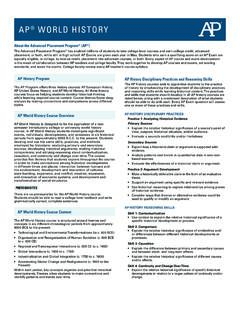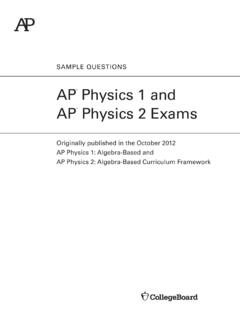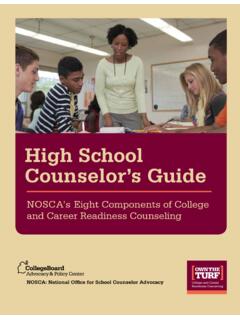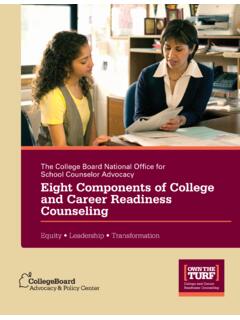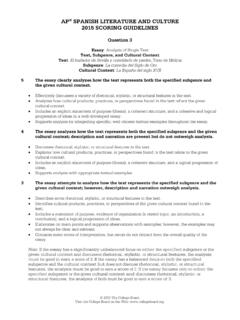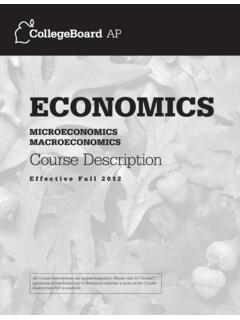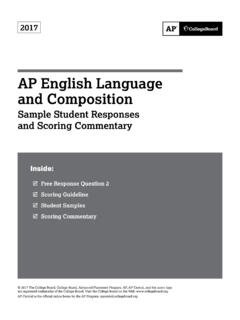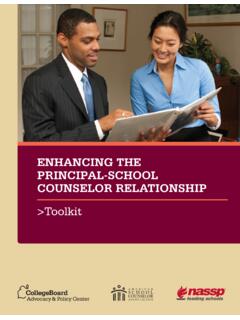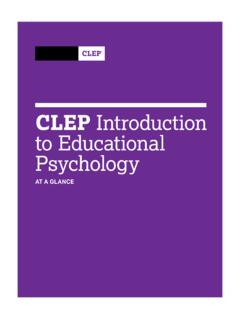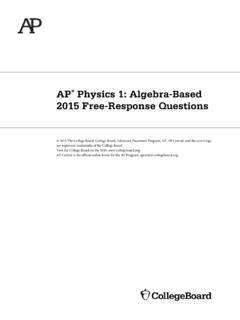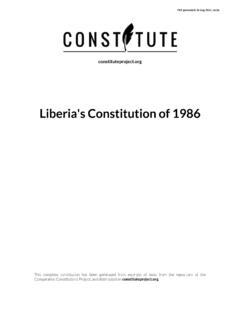Transcription of AP UNITED STATES HISTORY 2011 SCORING GUIDELINES
1 AP UNITED STATES HISTORY 2011 SCORING GUIDELINES 2011 The College Board. Visit the College Board on the Web: Question 3 To what extent did political parties contribute to the development of national unity in the UNITED STATES between 1790 and 1840? The 8 9 Essay Contains a clear, well-developed thesis that addresses the extent to which political parties contributed to the development of national unity in the UNITED STATES between 1790 and 1840. Develops the thesis with substantial and relevant historical information on the extent to which political parties contributed to the development of national unity in the UNITED STATES between 1790 and 1840. Provides effective analysis of the extent to which political parties contributed to the development of national unity in the UNITED STATES between 1790 and 1840; coverage of the time period may be somewhat uneven.
2 May contain minor errors that do not detract from the quality of the answer. Is well organized and well written. The 5 7 Essay Contains a partially developed thesis that addresses the extent to which political parties contributed to the development of national unity in the UNITED STATES between 1790 and 1840. Supports the thesis with some relevant historical information. Provides some analysis of the extent to which political parties contributed to the development of national unity between 1790 and 1840, but coverage of the time period may be uneven. May contain errors that do not seriously detract from the quality of the essay. Has acceptable organization and writing. The 2 4 Essay Contains an unfocused or limited thesis, or simply paraphrases the question. Provides minimal relevant information, or lists facts about political parties and the period 1790 1840 with little or no application to the question.
3 Provides limited or no analysis of the extent to which the political parties affected national unity ; may address only part of the time period indicated in the question. May have major errors. May be poorly organized and/or written. The 0 1 Essay Lacks a thesis or simply restates the question. Demonstrates an incompetent or inappropriate response. Has numerous errors. Is organized and/or written so poorly that it inhibits understanding. The Essay Is completely off topic or blank. AP UNITED STATES HISTORY 2011 SCORING GUIDELINES 2011 The College Board. Visit the College Board on the Web: Question 3 (continued) Information List: 1790 1824 Permanent political parties were not envisioned by the founders. The first and second party systems were national parties : compromise was necessary in order to function. Loose constructionists; strong central government; contract theory of government.
4 Federalists (Washington, who had Federalist leanings; Hamilton; Adams) Supporters were merchants, shippers, commercial farmers, and manufacturers in New England and along the Atlantic seaboard; identified more with Britain. Favored Hamilton s financial plan, which benefited the wealthier groups and the propertied classes; prosperity would trickle down to the rest of the population. National Bank: necessary and proper clause; implied powers. Protective tariff. Assumption of state debts; paying off the foreign debt; funding the debt at par; holding a manageable national debt. Excise tax on whiskey, which led to the Whiskey Rebellion. Strict constructionists; supported strong state governments and the compact theory of government; favored the inclusion of a Bill of Rights in the Constitution. Democratic Republicans (Anti-Federalists, Jeffersonian Republicans, Republicans, Jefferson, Madison, Monroe, J.)
5 Q. Adams) Supporters were small farmers in the South and West; appealed to the middle class and to the masses; favored an agrarian society and rule by an educated middle class; identified more with France. Did not support Hamilton s financial plan. Favored reducing the size of the military. Original election procedure in the Constitution provided that the top two vote-getting candidates would be president and vice president; later changed by the 12th A mendment (1804). The Time of the First Party System (1790s 1817) Jay Treaty with Britain (1794). Pinckney Treaty with Spain (1795). Washington s Farewell Address (1796). Election of 1796: Jefferson vs. Adams; Adams won. Alien and Sedition Acts (1798); Kentucky and Virginia Resolutions (1798); expiration or repeal of acts by 1802. Election of 1800: Jefferson vs. Adams; Revolution of 1800 ( We are all Republicans, we are all Federalists ); peaceful transfer of power from the Federalist to the Democratic Republican Party.
6 Midnight judges (1801). Marbury v. Madison (1803) and other decisions of the Marshall Court. Louisiana Purchase (1803). Tertium Quid was the name given to various factions of the Democratic Republican Party during the period 1804 1812; Quid was used pejoratively to describe cross-party coalitions of Federalists and moderate Democratic Republicans UNITED in opposition to Jefferson. Embargo Act (1807); Non-Intercourse Act (1809); Macon s Bill #2 (1810). AP UNITED STATES HISTORY 2011 SCORING GUIDELINES 2011 The College Board. Visit the College Board on the Web: Question 3 (continued) War of 1812: support for the war was greatest in Democratic Republican areas near the frontier, Canada, and Florida and was weakest in the Federalist maritime areas; Mr. Madison s War ; Clay, Calhoun, and Webster were war hawks. Hartford Convention (1814); Federalist negative response to the War of 1812; led to the death of the Federalist Party.
7 Surge of nationalism following the War of 1812. Second National Bank (1816). Tariff of 1816: first protective tariff in HISTORY . Henry Clay s American System proposed. Era of Good Feelings (1817 1824). Tallmadge Amendment (1819). Panic and depression of 1819. Missouri Compromise (1820). Foreign policy in the Era of Good Feelings ; Monroe Doctrine (1823). Reelection of Monroe (1820). Favorite-son election of 1824: Clay, J. Q. Adams, Jackson, Crawford. Corrupt bargain of 1824: Clay and J. Q. Adams. Information List: 1824 1840 Split of Democratic Republicans into National Republicans (and later Whigs) and Democratic Republicans (later Jacksonian Democrats Democrats). The Time of the Second Party System (1824 1840) Election of 1828/Revolution of 1828: J. Q. Adams (National Republican) vs. A. Jackson (Jacksonian Democrat). Indian Removal Act (1830).
8 Cherokee Nation v. Georgia (1831); Worcester v. Georgia (1832) (Indian removal). Peggy Eaton. Election of 1832: Jackson (Democrat) vs. Clay (National Republican), John Floyd (National Republican), and William Wirt (Anti-Masonic, the first third party). Jackson s veto of the bill to re-charter the Second Bank of the (1832); Nicholas Biddle, pet banks. Election of 1836: Democrat Van Buren vs. four Whig candidates. Liberty Party founded (1839); James G. Birney, candidate in the election of 1840; antislavery party. Election of 1840: Election of William Henry Harrison, the first Whig president; first modern election with vigorous campaigning on both sides; common man moving front and center and dominating elections; beginning of a more dynamic two-party system. Supported a stronger federal government; loose construction; Second National Bank. Emergence of the National Republicans (from the Democratic Republicans) Whig Party and Its Ideas Supported internal improvements (American System of Henry Clay).
9 Favored social reforms. Favored the evolution of a market economy, business, and industry; supported by small businessmen, professionals, manufacturers, and some southern planters. AP UNITED STATES HISTORY 2011 SCORING GUIDELINES 2011 The College Board. Visit the College Board on the Web: Question 3 (continued) Opposed to Jacksonian spoils system, executive power, common man. Opposed to Indian removal. Presidents: Harrison, Tyler (closet Democrat); prominent leaders: Henry Clay, Daniel Webster. Dissolved over sectional differences, particularly about slavery. Favored strict construction and STATES rights. Ideas of the Democrats (emerged from the Democratic Republicans, Jacksonian Democrats) Supported state banks and a tariff for revenue only. Favored western expansion. Opposed to internal improvements at federal expense and Clay s American System.
10 Not opposed to slavery or its extension. Supported Indian removal. Supported by Irish and German immigrants, poor farmers in the North and Midwest, small planters in the South, skilled and unskilled workers in cities and towns, the common man. Presidents: Jackson, Van Buren; prominent leaders: John C. Calhoun, James K. Polk (House Speaker), Thomas Hart Benton. Note: The Know-Nothing and Free Soil parties are outside the time period and were generally not relevant to the essays. 2011 The College the College Board on the Web: 2011 The College the College Board on the Web: 2011 The College the College Board on the Web: 2011 The College the College Board on the Web: 2011 The College the College Board on the Web: 2011 The College the College Board on the Web: 2011 The College the College Board on the Web: 2011 The College the College Board on the Web: UNITED STATES HISTORY 2011 SCORING COMMENTARY 2011 The College Board.
